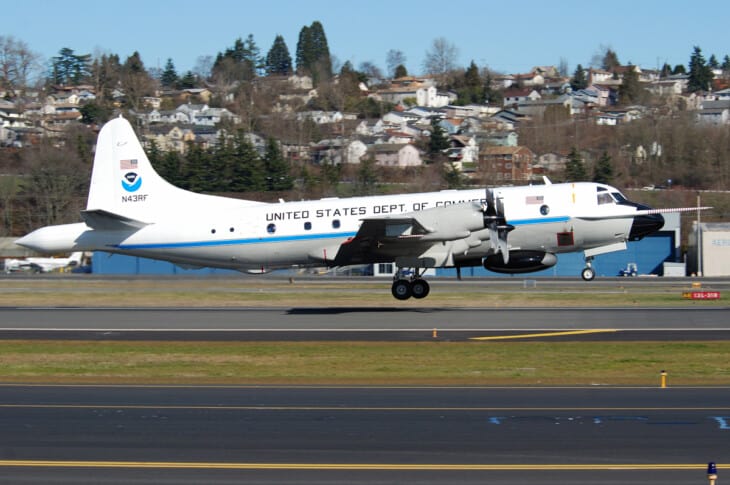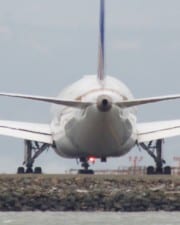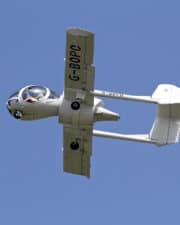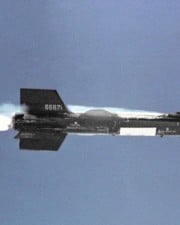Boeing’s main rival is often thought to be Airbus. However, Boeing also has another rival that’s often overlooked: Lockheed Martin. Both have been in aviation for decades and have a fierce rivalry, so how do Boeing and Lockheed Martin compare?
Looking at the current US air fleet, over 80% are from either Boeing or Lockheed Martin, including all of the military’s frontline jets. On a global scale, similar numbers ring true for other militaries, particularly in the West.
As both companies are huge, with thousands of employees and billions of dollars in revenue and profit, this article will compare the companies as aircraft manufacturers – not the multibillion dollar enterprises they are – and more importantly, the aircraft they’ve produced.
Who Are Boeing?
Boeing is one of the oldest players in aviation. The current company can trace its origins back to 1916, when industrialist William E. Boeing founded the Pacific Aero Products Company in Seattle, Washington.
In its early days, Boeing made a name for itself as a pioneer of seaplanes and flying boats for a mixture of military and commercial customers.
Whilst Boeing never truly abandoned producing military aircraft – particularly in wartime – the company became famous for its commercial aircraft, and developed a particularly strong rivalry with Douglas and Lockheed.
Since its founding, Boeing has been a pioneer of new aviation technologies; creating the first commercial aircraft with retracting landing gear (Boeing 247), the first pressurized revenue-taking commercial airliner (Boeing 307) and the first American-made commercial jet airliner (Boeing 707).
But perhaps the most famous Boeing aircraft is the 747, which was produced between 1968 and 2023. This aircraft was a huge gamble for Boeing as if it failed, so would Boeing, but the success of the 747 ensured the company’s survival for decades to come.
Fast forward to the 21st century, Boeing has its name on almost every achievement that makes America famous, from commercial aviation, to space to energy.
Who Are Lockheed Martin?
Lockheed Martin, by contrast, is a considerably newer company. Lockheed Martin was formed in 1995 as a result of the merger between the Lockheed Corporation and Martin Marietta.
Like Boeing, Lockheed traces its origins back to the dawn of aviation, to December 1926. Like Boeing, it made its name in commercial aviation, but after the failure of the L-1011 TriStar, became increasingly focused on military aviation.
Martin Marietta, on the other hand, specialized in the production of missiles and rockets, namely the Titan series. It was formed by a merger of the Glenn L. Martin Company (founded by the legendary Glenn L. Martin) and the American-Marietta Corporation in 1961.
Since its formation, Lockheed Martin has retained the business lines of its two predecessor companies, continuing to produce their products as well as designing and building their own, such as the F-22 Raptor and F-35 Lightning.
As one of Boeing’s main competitors, Lockheed Martin has begun to agglomerate further, expanding into other areas of aviation previously dominated by Boeing companies without Lockheed Martin competition, namely helicopters.
How Are Boeing And Lockheed Martin Similar?
The key similarity between Boeing and Lockheed Martin is that they are engineering companies first and foremost. And they are both engineering companies that started out in, and are primarily focused on, aviation.
Both companies produce aircraft, missiles and rockets that are used not only by the US military, but also by many of the world’s largest militaries, from the UK to Brazil to Japan to China, where their reputations are on a par.
Partly because of this, both companies are similar in terms of their level of R&D, at least in monetary terms, with both companies routinely placed in first and second place for how many billions they’ve plowed into R&D over the last year, decade etc.
But Boeing and Lockheed Martin are also similar in one other way: local economy. Both companies have plants all over the country, centered around cities with a rich history of aviation.
In turn, these cities’ economies rely on Boeing and/or Lockheed to survive, such as Seattle, Washington for Boeing and Palmdale, California for Lockheed Martin.
Similarly, the companies do not limit their manufacturing capabilities just to the US. Both companies have international subsidiaries located all over the world, including places like Canada and the UK.
How Are Boeing And Lockheed Martin Different?
Boeing and Lockheed Martin principally differ in terms of what they produce. Lockheed Martin has always been strictly a military contractor, whilst Boeing is a commercial aircraft manufacturer that also does military contracting.
Mostly due to this, the two companies differ in terms of their size. Thanks to its mix of commercial and military clients, Boeing is the much larger company by almost every metric:
Boeing has consistently beaten Lockheed Martin in terms of its revenue, profit, number of employees, number of products sold, number of products delivered and, the number of new contracts awarded.
Likewise, the companies also differ in how they go about doing R&D.
For Lockheed Martin, their R&D is very much directed by the world’s militaries so their aircraft can fit those militaries’ specific needs exactly. For Boeing, on the other hand, their R&D is more directed at how they can adapt previous R&D discoveries made for their military customers for commercial use.
The other main difference between Boeing and Lockheed Martin is their leadership.
Since the merger with McDonnell Douglas in 1997, Boeing has been led by business executives whose main goal is to increase stock price, whilst Lockheed Martin is run by engineers focused on making quality aviation products first, and shareholder returns second.
How Do Their Aircraft Stack Up?
With all that being said, there’s no way we can compare Boeing and Lockheed Martin without comparing their aircraft. For the purposes of this article, we will be comparing their aircraft families that are in most direct competition, and which are still in service.
Lockheed Martin F-16 vs Boeing F/A-18
Though General Dynamics developed the F-16, Lockheed and later Lockheed Martin, have been producing and developing it since 1993. It was developed as General Dynamics’ answer to the YF-17, which was later redeveloped into the F/A-18 Hornet, now produced by Boeing.
The F-16 principally beats the F/A-18 in terms of numbers. Indeed, the F-16 is the world’s most numerous fixed-wing military aircraft currently in service, with nearly 2,000 currently in service. By contrast, only 1,480 F/A-18s were ever made, and hundreds have since been retired.
The F/A-18, on the other hand, is a far more versatile aircraft. It is able to do all the fighter escorting, aerial suppression and air interdiction missions the F-16 can, with the added ability of being able to land on an aircraft carrier and greater ability for aerial reconnaissance, close air support and strike fighter roles.
Lockheed Martin F-35 vs Boeing X-32
Though the X-35 (now F-35) and X-32 were designed as competing aircraft for the Joint Strike Fighter (JSF) program, Boeing interestingly enough acts as a subcontractor for Lockheed Martin on the F-35 program, building much of the aircraft’s fuselage.
Aside from the main reason the F-35 is better – that it was actually selected for the program – the F-35 beats the X-32 in nearly all areas.
Its range is considerably longer than the X-32’s, its top speed is considerably faster and it requires a much shorter runway for the short takeoff and landing (STOL) requirement in the JSF criteria, making it far better suited for the kinds of operations the JSF would eventually be deployed on.
The X-32, however, made up for this by being far simpler electrically and mechanically. This made it cheaper to produce, and had it been accepted, would’ve seen a much lower price tag than that of the F-35 – one of its main criticisms.
Lockheed C-5 Galaxy vs Boeing 747
A lot of people don’t know that the 747 can actually trace its development back to the US Air Force’s CX-Heavy Logistics System program. Boeing submitted a design for the contract, but was ultimately turned down in favor of the Lockheed C-5 Galaxy.
Years later, the Boeing design would be modified for the commercial aviation market, where it met much success.
In any comparison of the two aircraft, the C-5 Galaxy inevitably comes out on top in terms of its size and volume. Though it can carry roughly the same amount of cargo as the 747, the C-5’s fuselage makes it perfect for carrying tanks, helicopters and other military equipment that the 747 cannot.
Partly because of its popularity in both military and commercial roles, the 747 beats the C-5 simply on how iconic it is. Indeed, it’s the flagship of choice for everyone from Pan Am to the President of the United States! You can’t get better than that!
Sikorsky CH-53 vs Boeing CH-47 Chinook
Sikorsky has been a Lockheed Martin company since 2015. This puts Lockheed Martin and Boeing in direct competition in the realm of heavy cargo helicopters, currently dominated by the Sikorsky CH-53 Sea Stallion and Boeing CH-47 Chinook families.
In a straight comparison between the two, almost all variants of the Sea Stallion beat the CH-47 in terms of its overall range, ferry range and speed. Indeed, several variants of the CH-53 serve as aerial tankers, a role which the CH-47 has never been deployed in or modified for.
But the Chinook sacrifices speed and range for its sheer cargo volume. Indeed, the internal cargo volume of the CH-47 is over three times that of the CH-53, and is one of the only helicopters to have ever been used as a commercial passenger aircraft (for dedicated helicopter airlines).
Conclusion
The main differences between Lockheed Martin and Boeing lie in their corporate makeup.
Boeing is a well diversified commercial aircraft manufacturer and defense contractor that’s seemingly made for Wall Street, whilst Lockheed Martin is solely a defense contractor that’s focussed on engineering first and Wall Street second.
As businesses, Boeing is undoubtedly the better between the two. It’s bigger by almost all metrics, is a more profitable company and is known around the world as the US’s premier aircraft manufacturer.
As aircraft manufacturers, however, the discussion does get somewhat murkier. Both companies have made some great aircraft, both by contemporary and modern standards, but both have produced their fair share of flops.
That being said, at least from the aircraft produced over the last 30 years, Lockheed Martin is undoubtedly the better company, producing the F-35 over the X-32, more F-16s than updated versions of the F/A-18 and CH-53 variants that are faster and longer range than newer variants of the CH-47.
Related Posts














